New approaches can improve kidney transplant numbers worldwide
Voucher programs or the creation of international transplant chains can have a tremendous immediate impact.

The demand for kidney transplants far exceeds the supply of organs. A wait-listed kidney recipient can expect to wait five to seven years in North America and even longer in other parts of the world. New approaches to increasing the number of matched kidney donor-recipient pairs can increase transplantation rates and help patients get the lifesaving kidneys they need.
“Just in North America we have more than 100,000 patients on the kidney transplant wait-list,” said Alp Sener, MD, PhD, FRCSC, chair and chief of urology at Schulich School of Medicine & Dentistry, Western University, in London, Canada. “If you extrapolate this to the rest of the world, the numbers can be staggering. Anything we can do to increase the number of potential donors will have a significant impact on the quality of life and lifespan of patients living with kidney disease.”
Dr. Sener will moderate the panel discussion “Novel Methods to Boost Kidney Transplantation Globally” on Monday from 1 to 1:20 p.m. Two panelists will discuss new approaches that may help increase the number of living donor kidneys available for transplantation.
Jeffrey Lorne Veale, MD, professor of urology at the University of California, Los Angeles David Geffen School of Medicine, has pioneered the use of a voucher system that effectively lets living donors give a kidney to a recipient today in return for a voucher that can later be redeemed for a future transplant by another person.
“The voucher could allow a parent whose child has a chronic kidney condition that will progress to transplantation at some point in the future to donate a kidney now for a wait-listed recipient,” Dr. Sener said. “In return, the parent gets a voucher that guarantees an organ in the future when his or her child has progressed to needing a replacement organ, and the parent is no longer in prime physical condition to donate. That kind of flexibility has opened up transplantation numbers. Dr. Veale will discuss the program and share the data they have collected.”
Michael A. Rees, MD, PhD, professor of urology and director of renal transplantation at the University of Toledo Medical Center in Ohio, has taken an international approach to ensuring patients across many countries receive lifesaving organ transplants. “Dr. Rees founded a nonprofit organization that works with transplant centers to find matches for incompatible donor and recipient pairs,” said Dr. Sener. “This program has grown internationally and helps countries maximize paired donation programs.
“Dr. Rees led the first global kidney exchange transplant in which a paired exchange mechanism was used to overcome the barrier of receiving a kidney transplant by a patient in another country,” he said. “Creating chains between donor-recipient pairs in North America and overseas can lead to better surgical outcomes for patients in underserviced countries. In this manner, everyone wins.”
Both approaches that will be discussed at the plenary session are highly regarded in the transplant literature in North America, Dr. Sener added, but slightly less so in urology because most of the transplants performed in North America are done by general surgery teams. It is important for urologists to know of the pioneering impact Drs. Rees and Veale are making on the global transplant community.
“Something as simple as voucher programs or the creation of international transplant chains can have a tremendous immediate impact on patient care and survival,” Dr. Sener said. “At the same time, they can have a multimillion-dollar impact on the total health care system by getting patients off of costly dialysis.”